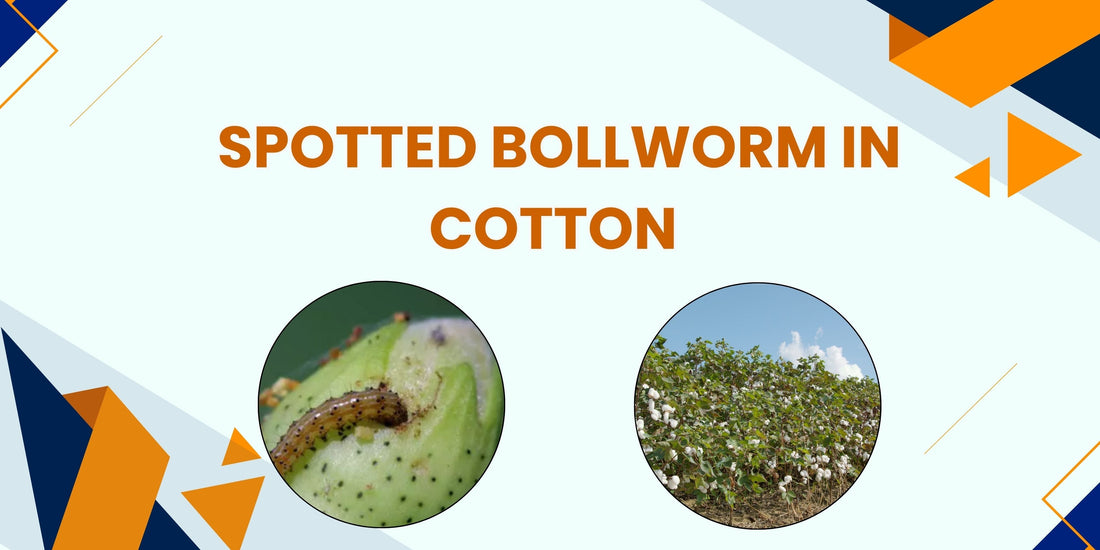
SPOTTED BOLLWORM IN COTTON
Scientific name: Earias vitella ,Earias insulana
Identification of the Pest:
Identification of the pest: E. vitella
- Larva - Brownish with white streaks dorsally and pale yellow ventrally, Without finger shaped processes
Adult
- Small buff coloured. 0
- Forewings are pea green with a wedge shaped white band running from base to out margin.
Identification of the pest: E. insulana
Larva: Brown with dorsum showing a white median longitudinal streak.
The last two thoracic segments and all the abdominal segments have two pairs of fleshy tubercles (finger shaped processes) one dorsal and the other lateral
Pupa: Brown and boat shaped.
Adult: Small buff coloured. Forewingsare uniformly silvery green.
Lifecycle:
1. Egg Stage:
- Female moths lay tiny eggs on cotton leaves, flower buds, or bolls.
- The eggs hatch in 3-5 days.
2. Larva Stage (Caterpillar):
- Once the eggs hatch, tiny caterpillars emerge and ready to feed.
- They crawl onto the cotton buds, flowers, and bolls, nibbling away and leaving small holes behind.
- These holes not only damage the cotton but also reduce its quality and yield, creating significant problems for farmers.
3. Pupa Stage:
- Once fully grown, the caterpillars drop to the soil or hide in plant debris to form pupae.
- They remain in the pupa stage for 7-10 days.
4. Adult Stage (Moth):
- Adult moths come out of their cocoons and start the cycle again by laying eggs.
- The complete process takes about 30-40 days, depending on the weather conditions.
Symptoms:
- Drying and drooping of terminal shoots during pre –flowering stage
- Shedding of squares and young bolls
- Flaring up of bracts during square and young boll formation stage
- Holes on bolls and rotting of bolls.
Favourable Conditions:
- Warm weather with temperatures between 25-30°C helps the pest multiply faster.
- Moderate to high humidity levels create ideal conditions for their growth.
- The pest attack is more during flowering and boll formation stages.
- Leaving plant debris or unharvested cotton bolls in the field provides shelter for the pest to survive and breed.
ETL: 10% infested shoots/squares/bolls.
Management:
Cultural Practices:
- Remove and destroy previous crop residues and damaged bolls after harvest to prevent the pest from surviving.
- Follow crop rotation. Rotate it with non-host crops like pulses or cereals.
- Sow the crop at the right time to reduce pest infestation. Late sowing increases the risk.
- Plant trap crops like okra (bhindi) around the cotton field to attract and divert the pest.
Biological Control:
- Encourage beneficial insects like Trichogramma that attack bollworm eggs.
- Install bird perches in the field to attract birds that feed on caterpillars.
Chemical control:
- Egg Stage: Spray insecticides like Chlorantraniliprole or Flubendiamide to kill eggs and small larvae.
- Larva Stage: Use Spinosad, Emamectin Benzoate to control larvae.
- Avoid Overuse: Do not use the same chemical repeatedly to avoid resistance in pests. Follow recommended doses and intervals.
- For effective control of bollworm infestation use Biopesticide “LARVEX”.

FAQs:
1. What are the symptoms of spotted bollworm infestation in cotton field?
Drying and drooping of terminal shoots during pre –flowering stage,Shedding of squares and young bolls,Flaring up of bracts during square and young boll formation stage,Holes on bolls and rotting of bolls.
2. What are the susceptible stages for spotted bollworm attack?
It usually attacks during the flowering and early boll development stages. Be vigilant during these phases of cotton growth.
3. What is the Economic threshold level for Spotted bollworm?
10% infested shoots/squares/bolls is the ETL for Spotted bollworm.
4. Should I spray pesticides for spotted bollworm?
Only as needed. Choose targeted insecticides recommended by experts and rotate chemicals to prevent resistance.For effective control of bollworms use Biopesticide “LARVEX”.
5. Are there cotton varieties resistant to spotted bollworm?
While no specific variety is fully resistant, some hybrids and Bt cotton offer partial protection. Combining resistant varieties with proper management works best.
